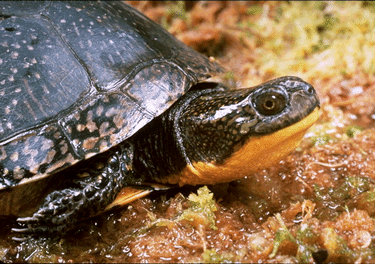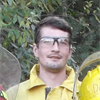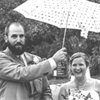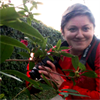Natural Area Preservation News
Protecting and restoring Ann Arbor's natural areas and fostering an environmental ethic among its citizens.
Volume 19, Number 4
Winter 2014-15
Park Focus: White Oak
Kristen Schotts
Some of Ann Arbor's parks are overlooked by the general public, tucked away in neighborhoods not frequently visited by the masses; White Oak Park is one such place. Few outside of the Newport Hills subdivision know of this 3-acre natural area bordered by White Oak and Pin Oak Drives. The subdivision was developed in the 1990s and the park was set aside with as few trees removed as possible so that when the neighborhood was established the residents would have a green space to enjoy. The park has faced its challenges: the dumping of yard waste, invasive species, and a nearly impassable understory that made the park uninviting to use. In the early 2000s, plans were set in motion to improve the park so as to be more accessible to residents. A single path running east to west was created. Along the path, two benches, a picnic table, and a small play structure were installed to give the local children a place to play outdoors. Though the park was recreationally improved, it still faced an uphill battle with invasive species. This past June, White Oak Park gained two park stewards: David Repp and Richard Greglio. They each began individually removing an aggressive vine, Asian bittersweet from the park land that bordered their backyards. When they ran into each other in the park and realized they were doing the same thing, they wondered if it was actually illegal to be making these alterations. They checked in with the City and to their surprise were offered the positions of park stewards. After visiting high quality woods in other parks, David and Richard saw what White Oak could become if restored. They were determined to help White Oak reach its full potential.

In a few short months, and after over 70 hours of work, the stewards have cleared an enormous amount of invasive shrubs and small trees (honeysuckle, buckthorn, and autumn olive). The local deer check in on them while they work, following behind them a short distance to munch on the honeysuckle leaves as the shrubs are felled. In my visit to the park, I looked behind me to see a young, 4-point buck standing 20 feet away, watching expectantly. After following along for a few steps, it realized I wouldn't be giving it an easy buffet, and it trotted off through the woods. With the understory freed of the dense, invasive shrubs, the park can be better used to observe wildlife. The oak trees that dominate the park now have room to expand and bring up new seedlings to bask in the light that is finally able to make its way to the forest floor. Other native plants now have a better chance to grow and develop into mature trees that will provide habitat for wildlife in this small refuge between the houses.
The restoration process for White Oak Park is far from over. Invasive species will need to be continually managed for years to come. Restoration never relies on one tool. Invasives here can be controlled via cutting shrubs, pulling herbaceous plants, applying herbicide where necessary, and seeding the park with natives. The park may even benefit from NAP's controlled burns. Weather permitting, White Oak is one of the parks on the wish list this fall to use fire to control invasive species, and encourage native plants – especially oaks. However, the one tool that restoration always relies heavily upon is enthusiastic volunteers. Without volunteers, we would be far lacking in the amount of manpower needed to oversee and maintain Ann Arbor's numerous parks. If you ever doubt the impact you can make, visit White Oak. See the changes David and Richard were able to make. With continued effort and patience, the park will only continue to improve and become yet another of Ann Arbor's hidden natural gems.
Coordinator's Corner: Home
Dave Borneman, Deputy Manager for Volunteerism and Natural Area Preservation
A few years ago, when Skyline High School was being built, NAP conducted a "herp rescue" of reptiles and amphibians headed to the wetland that had been destroyed during construction. I was amazed to learn from our herpetologist that frogs and salamanders return each year to breed in the same pond where they themselves were hatched, and some salamanders may live 20 years or longer. If that pond is destroyed, and those herps are moved to a different pond to breed, some of them will accept that new pond. But some will reject it and keep trying to get themselves back to where they think they are supposed to be. As the years go by, the number of frogs and salamanders trying to get back to that old pond has decreased. I suppose that's either because the old herps die off or because they "give in" and finally accept that the new pond is their new home.
We highly evolved primates must still retain a bit of this primitive, reptilian brain matter. As flexible and adaptive as we are as a species, some of us still find ourselves clinging stubbornly to our past. I reflect on this during these holiday months. I officially left home when I was 17, heading off to my first summer job after high school, then away to college. For the past 21 years Ann Arbor has been my home. Still, every year of my life, whenever it is at all possible, I am drawn to return to my boyhood home - the family farm in northern Illinois - for Thanksgiving, Christmas, and other major holidays. Intellectually, I know there is nothing ecologically unique or special about these 160 acres of Midwest farmland. I drive past hundreds of similar farms on the 353-mile pilgrimage that I make several times a year. Still, there is something that stirs deep within me when I come up over the last little rise and see the familiar red barn, the old silo, the broken windmill, the big shade trees, and the old house where my dad was born nearly 100 years ago. I'm home.
We really aren't so different from those frogs and salamanders. Many of us are imprinted with a "sense of place" that profoundly feels like home to us. So what do w do when that old home disappears, or is taken away from us? Some of us will more easily adapt to a new home. We'll put down new roots, make new friends, start new traditions, begin a new life. Others of us will keep trying to get ourselves back to that old pond, year after year, even when it's no longer there. So how do you make a new place truly feel like "home?" How do you make that transition? Here's a suggestion: roll up your sleeves, jump in, and start working to improve your new location. Invest in your local natural areas. Take ownership in them. Join NAP or Adopt-A-Park at some upcoming workdays. Better yet, step up and volunteer to be a Park Steward there. Doing so will make those areas more valuable to you. Before long, you may just find that you've put down some new roots. And you may once again enjoy that sense of "home" without even needing to go in search of your old pond.
2014 Program Reports
From Workday Coordinator, Mary Adams:
· NAP has hosted 65 public and 42 private workdays
· Forty-four groups and 2,473 individuals volunteered at NAP workdays
· We've recorded 8,079 volunteer hours this year!
From Adopt-A-Park Coordinator, Quentin Turner:
· AAP hosted over 70 workdays
· We increased the number of adopted parks by 10%
· Over 100 individuals volunteered in more than 60 parks
From Park Steward Coordinator, Dana Burnette:
· NAP has 75 Park Stewards across 39 city natural areas
· Brooks Curtis has accrued an impressive 110 volunteer hours in Sunset Brooks Nature Area
· Richard Geglio and David Repp worked as a team to clear White Oak Park of invasive honeysuckle, autumn-olive, and buckthorn in the 3-acre park
· Stewards at Bluffs Nature Area are moving forward with the installation of a new trail entrance so that park neighbors have official access to the park from the west
· Dicken Woods Nature Area's stewards removed invasive species and replanted with natives along South Pauline Drive and around oak trees they planted years ago
· Bill Kidd and Aunita Erskine teamed up to maintain a native plant garden and push back the invasive species in the prairie and woodland at Furstenberg Nature Area
· Leonore Gerstein is tackling the Asian bittersweet vines that threaten to take over Oakridge Nature Area
· The stewards at Stapp Nature Area spent many hours removing shrubs around the sensitive vernal pond
· Judy and Manfred Schmidt spent countless hours in Scarlet Mitchell Nature Area and attended every possible workday at the site
· Shannan Gibb-Randall and Kay Werthan worked together at Hannah Nature Area to be the neighborhood liaisons and recruit others to public workdays
· Jeannine Palms led the Buhr Park Wet Meadow Project, maintained the meadows, and partnered with community groups to expand the project
From NAP Herpetologist, Patrick Terry:
· Over 500 hours of herp volunteer effort were recorded along with over 250 herps counted
· Rare and uncommon species sightings for the year include: Musk Turtle, Blanding's Turtle, Tiger Salamander, Spiny Softshell Turtle and American Bullfrog
· 120 Day Campers were educated through the Gallup River Camp
· Corrie Navis volunteered an impressive 65+ hours with the herp program and attended every group event

NAPpenings:
Thank you!
Many thanks to the groups who volunteered with NAP recently. We could not make such a difference without you!
Youth Volunteer Corps
General Electric
Phi Beta Sigma
Concordia University
Emerson Staff and Faculty
Greenhills Staff and Faculty
UM Law School
EMU Vision
Michigan Community Scholars Program
Washtenaw Technical Middle College
Greenhills 7th grade
Toyota Boshoku America
Pioneer Interact
UM Environment 201
UM Alpha Phi Omega
St. Francis Middle School
UM Epeians
EMU Delta Tau Delta
Westminster Church
Michigan Community Scholars Program
Asa Gray Neighborhood
Osprey Platforms Coming
Keep your eyes out for two osprey nesting platforms which we are planning to install soon in or near the Huron River as part of a joint project between NAP, the Huron River Watershed Council, the Washtenaw Audubon Society, and Osprey Watch of Southeast Michigan. The platforms serve as a safe place for osprey to nest and rear their young. Specific locations are still being finalized.
New County Natural Area
Next time you visit Marshall Park, be sure to follow the trails to the west and check out Washtenaw County's newest preserve. The recently acquired Tom A. Freeman Preserve now connects nearly 300 acres in northeast Ann Arbor between Marshall Park, the Goodrich Preserve, and Horner-McLaughlin Woods.
Ann Arbor Community Wildlife Habitat
A coalition of Ann Arbor citizens and environmental groups including NAP has begun the process of applying to become a Certified Community Wildlife Habitat, as designated by the National Wildlife Federation. They are working towards certification for both the city of Ann Arbor and Washtenaw County.
2015 Stewardship Network Conference: The Science, Practice & Art of Restoring Native Ecosystems
The Stewardship Network will be hosting its 2015 annual conference in East Lansing from Jan 23-24. The conference will offer an array of plenary talks, focused presentations, networking opportunities, and workshops. For more information, visit www.stewardshipnetworkconference.org.
Staff Updates
Welcome:
 Drew Zawacki, Field Crew
Drew Zawacki, Field Crew
I graduated from Eastern Michigan University with a B.S. in Biology. After graduating, I moved out west where I worked in invasive plant management for the National Parks Service and did ecological restoration for a private ecosystem management company. I'm excited to move back to Ann Arbor and to help restore the natural areas in the area where I grew up.
Congratulations:
 Tina Stephens
Tina Stephens
NAP Volunteer and Outreach Coordinator, Tina Stephens (Roselle), married Peter Stephens on September 20 at Matthaei Botanical Gardens. Several past and current NAPpers were in attendance at the wet and wild celebration.
 Rachel Nagel
Rachel Nagel
NAP Field Crew member, Rachel Nagel (Weston), was married on September 12 at St. Thomas the Apostle Church to Paul Nagel of Dexter, Michigan. Rachel's husband is a videographer and is a welcomed addition to NAP's extended family. Rachel and Paul live in Ann Arbor and spend their free time playing Frisbee and Nintendo games.
Farewell:
 Laura Mueller, Field Crew, Adopt-A-Median, and Photo Monitoring
Laura Mueller, Field Crew, Adopt-A-Median, and Photo Monitoring
I started at NAP in 2008 and will miss all of the friends I made while working on the field crew, as the photo monitoring coordinator, and as the Adopt-A-Median Coordinator. During the past year, I was able to share my years of experience and institutional knowledge when welcoming new Stewardship Specialists and crew members. I will be moving on to the Matthaei Botanical Gardens to serve as the Great Lakes Garden Field Tech. Come visit me at Matthaei any time!
 Renée Hytinen, Communications and Special Events
Renée Hytinen, Communications and Special Events
The last three and half years have been a whirlwind of fun with volunteers and fun at home with my growing family. Sadly, it is time for me to move on. I will be working for The Hope Foundation, a public charity with the mission of raising and contributing funds for the treatment and prevention of cancer. I already miss everyone at NAP and serving this fantastic community of volunteers!
 Rachel Voyt, Outreach Assistant
Rachel Voyt, Outreach Assistant
I had a great time this year at NAP, pursuing my interest in making environmental knowledge accessible to the public. I will miss working with NAP and Adopt-A-Park volunteers!
Eagle Scout to Install Signage at Dolph Nature Area
Nate Helberg, Eagle Scout Candidate
I have been in scouts since I was six years old. I have progressed through the Cub Scout ranks, earned my merit badges and other requirements for multiple Boy Scout ranks, and now I am working on my Eagle Scout project. The whole point of an Eagle Scout project is to show leadership throughout: create the project idea, work with your troop leader to approve the idea, coordinate fundraising, create and assign jobs that need to be done, and execute your entire plan while leading adults and younger scouts.
For my Eagle Scout project I have decided to install directional signage in Dolph Nature Area. There will be five four-sided signs pointing to landmarks throughout the park. I have cleared my project with the Eagle Scout Committee and am working on stenciling, routing, and painting the letters now.
Throughout this project I have learned how incredibly challenging it is to design and execute an idea. I was not anticipating all of the expectations and requirements I had to meet in order to just approve my project. I spent about four months just planning out my project idea; my signage layout has changed three times in those four months. It has been a lot more work that I had originally anticipated, but I am having fun watching my project as it unfolds.

2014 Eagle Scout Projects
Nate Helberg has planned, designed, and is now installing directional signage at Dolph Nature Area. These posts will direct park users to street accesses, the parking lot, and various park features such as the pond and First and Second Sister Lakes.
Congratulations to Jonathan Lee! He recently completed his Eagle Scout project building a bridge over a small tributary to the Huron River in Argo Nature Area. Because of Jonathan's efforts, the trail at Argo will be safer and the sensitive wetland ecosystem that had previously been disturbed by foot traffic will be restored.
